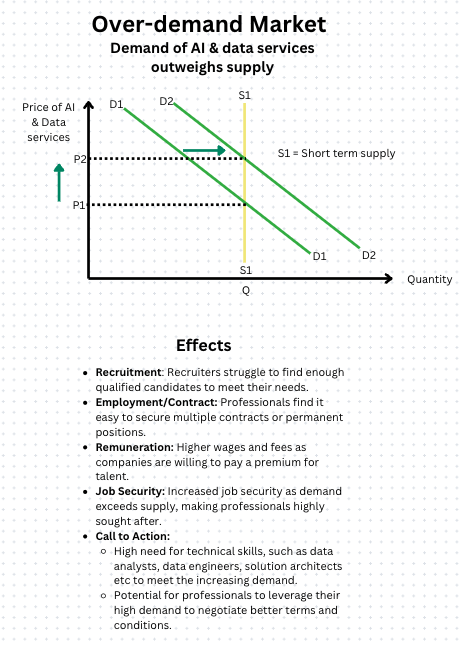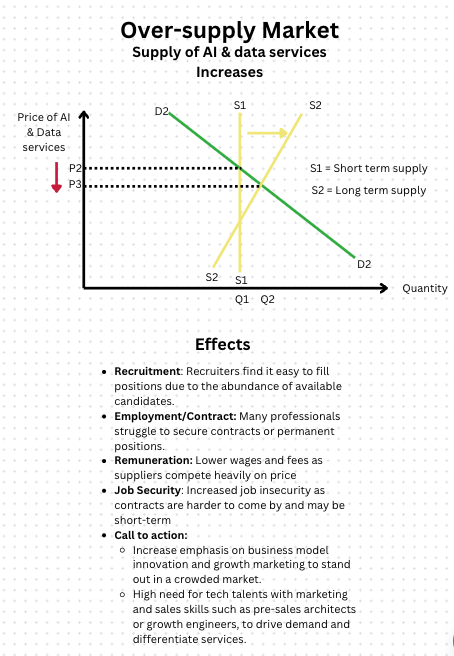Mastering the Market: How Non-Tech degree holders Can Navigate AI & Data Analytics Supply and Demand for Unmatched Growth
To get notified when articles are published
Introduction
In every job market, including AI & data analytics, it’s challenging to predict how the market dynamics will behave tomorrow and in the future. However, with guided principles of basic economics such as demand and supply equilibrium, non-tech degree holders with interest AI & data analytics can make informed and confident decisions about which skills to learn and how to approach and enter the job market.
In this article, non-tech degree holders will discover how the two main forces of any market—demand and supply—affect the dynamics of the AI and data analytics market. Understanding how these forces interact is vital for shaping the decisions of non-tech degree holders in the current unstable and indeterministic AI and data analytics market.
As a non-tech degree holders, you will uncover the following important insights about the AI & data analytics job market:
- The most important market economic scenarios as determined by the movement of the demand and supply forces.
- The market effects of each economic scenario on key decisions such as skill development and recruitment.
- The recommendations or actions to take for each scenario to build and advance your professional career.
Scenario 1: The Over-Demand AI & Data Analytics Market
Whenever there is a trend or new innovation showing promising results, almost every company wants to join the party, causing a spike in demand. This is what we are experiencing with the unprecedented advancement in generative AI. With the “hype,” there is a high demand for AI & data analytics services, and not enough supply to meet the demand level.
The figure below illustrates how the demand curve shifts from D1 to D2, but the quantity supply is fixed due to few data professionals. As a result, the value (price) to acquire AI and data analytics services increases from p1 to p2. As a non-tech degree holders, this is the best period to learn Ai & data analytics skills because the market favours you

The over-demand market scenario causes the following effects:
- Recruitment: Companies in need of AI & data analytics services struggle to find qualified candidates because they are in high demand.
- Employment/Contract: AI & data analytics professionals find it easy to secure high-value deals because many companies need AI & data analytics services.
- Remuneration: AI & data analytics professionals enjoy premium prices for their services as there is an increased need for their services.
- Job Security: AI & data analytics professionals are over-booked, ensuring a good level of job security.
- Implications: High need for technical skills (e.g., data analysts, data engineers) to meet the increased demand.
Actions to maximise this opportunity:
- Acquire more technical AI & data analytics skills to take advantage of the demand.
- Good opportunity to secure new long-term permanent contracts with companies.
As a non-tech degree holder, you have two choices: allow natural market forces to maintain this state or take deliberate actions to ensure your career is always in this favourable position. The goal is to always drive demand to put your skills in an over-demand state. This is the same principle used by top professionals to drive traffic-demand, making 6-7 figure of profits year in and year out.
Scenario 2: Over Supply AI & Data analytics Market.
With the buzz around AI & data analytics, it’s no surprise to see many AI & data professionals joining the party in the long run. Many universities lunch new AI & data programs causing the influx. If the demand remains fixed at D2, an oversupply of AI & data professionals occurs. That is, more people are readily available to provide the same services to the fixed number of companies wanting those services.
The effect of oversupply in the market is illustrated in the figure below. Due to the increase in supply, the supply curve moves from S1 to S2, causing the quantity supplied to increase from Q1 to Q2. As a result, there is a decrease in the value (price) of AI & data services, assuming demand stays fixed. This situation is not ideal for AI & data professionals as the competition becomes stiff and competitors are willing to lower their rates as much as possible, favouring the consumers (companies in need).

The over-supply market scenario causes the following effects:
- Recruitment: Due to surplus AI & data professionals, recruitment is negatively affected.
- Employment/Contract: The competition is very tight, making it challenging for AI & data professionals to secure employment contracts with companies.
- Remuneration: The prices for AI & data analytics services drastically drop. AI & data professionals compete on price as many are willing to lower rates to secure deals.
- Job Security: Job security is low as it’s difficult to find opportunities. There is serious competition for the relatively few opportunities compared to the number of AI & data professionals.
- Implications: Layoffs are very visible. Companies won’t want to keep employees on the bench doing nothing for the company.
- Implications: High need for sales skills (e.g., pre-sales architects, growth engineers) to drive demand and differentiate services in a competitive market.
Actions to stay competitive:
- Acquire marketing and sales skills because companies will be in need for such skills to drive demand and get new projects
Conclusion
As a non-tech degree holder, understanding how the demand and supply curve of your AI and data analytics markets shifts relative to the equilibrium is crucial for making informed decisions about skill development and professional growth. Relying solely on general market forces can leave you behind. Instead, proactively position yourself to stay ahead of competitors and grow even during recession times.
What you’ve learned from this article is just one of the six core concepts covered in my white paper: Education to professional Employment (E2PE) framework. This white paper aims to help non-tech degree holders transition to AI & data analytics within 3-6 months and land 5 to 6-figure salary jobs working from home. Haven’t grabbed a FREE copy yet? Click HERE to do so now.
To win the game of securing high valued AI & data employment contracts, you need to understand the supply and demand dynamics of the AI & data analytics market.
Author: Ivo Kubam
Date: 12-08-2024
Graffiland
Found this article insightful?